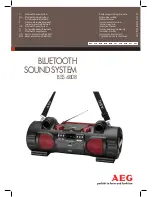
8.1
Glossary
8.1.1
A
ACD
Automatic Call Distribution. A computerized phone system that responds to the caller with a voice menu,
and connects the call to the required agent. It can also control call flows by automatically routing calls in the
order of arrival.
ACSE
Association Control Service Element. OSI convention used for establishing, maintaining and releasing
connections between two applications.
ADN
Additional Designation Number.
AFU-1
Auxiliary Function Unit. Daughter board of the PowerCPU board supporting ancillary functions such as
general bell, doorphone, audio in, audio out, etc.
AMIX-1
Mixed analog equipment board: analog accesses with CLIP functionalities, analog and digital terminal
connection interfaces.
AP
Access Point. A device that acts as a switch between the wireless LAN (802.11a, b, or g) and the wired
LAN (802.3). There are two types of APs: Thin and Fat. The newer Thin technology AP consists of a thin
AP and an access controller (also known as a wireless controller). Only the time-critical functions are
managed by the thin AP. The other features are managed by the access controller.
APA
Analog Public Access. Board allowing the connection of analog network lines (switched network) with CLIP
functionality. That board, equipped with GSCLI boards (Ground Start), is compatible with the American
public network.
API
Application Programming Interface
ARI
Access Right Identifier. System identification number (DECT feature).
ARS
Automatic Route Selection. A logic direction is a set of trunks used for a call with the following facilities:
seeking out the optimal path for a call, using the least-cost operator or network; overflow management:
enables a PCX to find a new route to make an outgoing call when there are no resources available in the
initial trunk.
ASN-1
Abstract Syntax Notation 1. OSI language for describing data types independently of processor structures
and technical representations.
ATA
Analog Trunk Access. Board for connecting analog network lines (switched network).
8.1.2
B
BACKGROUND MUSIC
External device (e.g. radio tuner) that can broadcast music over the loudspeakers of idle terminals;
broadcasting is stopped automatically if there is an incoming call to the terminal or if the user makes a call.
8-1
Содержание OmniPCX Office
Страница 1: ...Installation Manual Release 9 0 October 2012 ...
Страница 8: ... P 8 6 Q 8 7 R 8 7 S 8 8 T 8 8 U 8 9 V 8 9 W 8 9 0 6 ...
Страница 14: ...Chapter 1 1 6 ...
Страница 19: ...2 3 Installation 2 3 1 Overview ___change begin___ 2 5 ...
Страница 48: ...Chapter 3 3 18 ...
Страница 176: ...Chapter 4 4 128 ...
Страница 178: ...Figure 5 1 Virtual Key Functions for Operator Sets in KeySystem mode Chapter 5 5 2 ...
Страница 179: ...Figure 5 2 Virtual Key Functions for Manager Assistant Normal sets in KeySystem Mode 5 3 ...
Страница 180: ...Figure 5 3 Virtual Key Functions for Attendant sets in KeySystem Mode with no Physical Add on Chapter 5 5 4 ...
Страница 181: ...Figure 5 4 Virtual and Physical Add on Key Functions for Attendant Sets in KeySystem mode 5 5 ...
Страница 182: ...Figure 5 5 US only Virtual Key Functions for Operator Sets in KeySystem Mode Chapter 5 5 6 ...
Страница 183: ...Figure 5 6 US only Virtual Key Functions for Manager Assistant Sets in KeySystem Mode 5 7 ...
Страница 184: ...Figure 5 7 US only Virtual Key Functions for Normal Sets in KeySystem Mode Chapter 5 5 8 ...
Страница 185: ...Figure 5 8 Virtual Key Functions for Operator Manager Assistant Normal Sets in PABX Mode 5 9 ...
Страница 186: ...Figure 5 9 US only Virtual Key Functions for Operator Sets in PABX Mode Chapter 5 5 10 ...
Страница 187: ...Figure 5 10 US only Virtual Key Functions for Manager Assistant Sets in PABX Mode 5 11 ...
Страница 190: ...Chapter 5 5 14 ...
Страница 213: ...settings are overwritten when configured PBXs are added to a network 6 23 ...
Страница 214: ...Chapter 6 6 24 ...
Страница 220: ...Chapter 7 7 6 ...










































